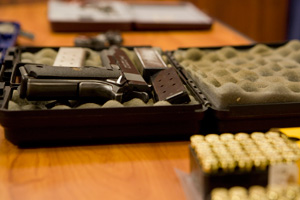Gangs Division
The District Attorney's Gangs Division prosecutes the most serious gang crimes committed in the county. The Gangs Division is a vertical prosecution unit which combines Deputy District Attorneys with District Attorney Investigators to handle the unique and dangerous issues that arise in gang prosecutions. Led by Division Chief Dana Greisen and Assistant Chief Robert Hickey, the division's staff is some of the finest in the nation.
 Last year, the Gangs Division continued its proactive role with local, state, and federal law enforcement. Prosecutors and investigators participated and assisted with numerous task forces aimed at gang members and the crimes they commit. The cooperation of the District Attorney's Office with local, state, and federal authorities is at the highest level in the area of gang prosecution.
Last year, the Gangs Division continued its proactive role with local, state, and federal law enforcement. Prosecutors and investigators participated and assisted with numerous task forces aimed at gang members and the crimes they commit. The cooperation of the District Attorney's Office with local, state, and federal authorities is at the highest level in the area of gang prosecution.
As part of this approach, the Gangs Division continued to participate in targeted operations, which have been highly successful in addressing gang crime in San Diego. Each member of a gang is targeted for the crimes they commit regardless of their role in the gang. This zero-tolerance approach disrupted some of San Diego's most violent gangs and resulted in convictions for charges including drug sales, prostitution, armed assaults and murder. As a result, gang homicide rates in the City of San Diego are below the average of the last two decades, declined from 2012 to 2013, and remains well below historic rates and well below that of most major metropolitan cities.
Another area of gang suppression is the Border Crimes Task Force, which was founded in 2009 through a federal grant. Three Deputy District Attorneys and one investigator are assigned to the task force. Along with federal and state law enforcement, the task force combats violent crime including murders, kidnappings, robberies and narcotic trafficking associated with major Mexican drug cartels. This task force coordinates efforts of law enforcement and prosecution to effectively combat the growing threat of serious and violent crime occurring in San Diego as a result of drug cartel influence in Mexico. One of the main prosecutions has been against a criminal organization called "Los Palillos," whose members have committed numerous kidnappings and murders on U.S. soil. In 2013, three gang members from this group received life sentences for their roles in murders and kidnappings. Meanwhile, three of our Gang Division prosecutors spent the entire calendar year in a death penalty trial against two Los Paliliios members for nine murders. That trial will continue in 2014.
Prosecutors in this division continue to use all avenues to suppress gang crime including undercover operations and gang injunctions to stop violence before it occurs.
While there are hundreds of success stories in this division, the ongoing seriousness of gang violence in San Diego is reflected by the kinds of cases and defendants prosecuted in 2013.
Major cases included:
People v. Tamoya Morris
On the morning after Thanksgiving 2005, Tamoya Morris and other gang members broke into a home in the Valencia Park neighborhood in an effort to extort money from one of the residents. While there, they bound and gagged five people and held them at gunpoint for the entire day. One of the male victims, Meico McGhee, was severely beaten, along with a female victim, Sacha Newbern. They were placed in a bathtub and doused with gasoline. Morris and the other suspects then threatened to light the two on fire if they weren't given the money they sought. In the evening, after it became clear that there was no money in the home, the suspects executed Mr. McGhee and Ms. Newbern by shooting them in the head. Morris was eventually identified as a suspect through DNA found at the scene.
Morris was also implicated in a 1995 drive by murder where he shot and killed a gang rival. Morris was identified by a single hand print on the outside of the door of the car that had to be placed there close in time to the murder and consistent with a person leaning out of the car window while firing a gun.
After two trials Morris was convicted for both the above murders then was sentenced to multiple life terms without parole.
People v. Bejeran, Gibson and Hamilton
In May 2011, three gang members entered a park in Oceanside looking for rivals or any Hispanics to kill on behalf of their gang. A 16-year-old boy and 13-year-old girl were socializing in the park at the time. The leader of the gang members, Al' C Bejaran, found the youngsters in the park and executed them with a gun at close range. Bejaran was identified by an informant and DNA on a hair pick found near the murdered children. Gibson and Hamilton were identified by the informant and their own self-serving admissions.
In the fall of 2013, all three pleaded guilty. Gibson and Hamilton were sentenced to lengthy prison terms while Bejaran was sentenced to life without the possibility of parole.
People v. Demetrius Sissac
On October 30, 2011, gang member Demetrius Sissac shot and killed a hard- working cab driver, Jalaludin Hamrah. Sissac shot Hamrah in the back of the head as Hamrah dropped off Sissac and the rest of Sissac's group of friends. The car then drove off out of control and flipped over. The only explanation for this cold-blooded killing came from the defendant himself. Immediately after the shooting, Sissac was confronted by his friends about why he would shoot a man for no reason. Coldly, the defendant stated, 'He laughed at me.'
After trial an El Cajon jury convicted Sissac of second-degree murder with a gun allegation then was sentenced to multiple life terms.
People v Steven Sanders
In late 2012, former San Diego Hells Angels President Sanders was in San Diego County jail for numerous crimes of violence including two kidnappings, when he solicited at least two fellow inmates -- also criminal street gang members -- to murder witnesses to his crimes and the prosecutors leading those pending trials.
Upon learning of Sanders' proposed conspiracies, the Gangs Division led a multi-agency operation to protect the threatened and build a provable case against Sanders. This operation produced many hours of recorded conversations between Sanders and an informant in which Sanders proposed methods and weapons for the informant to use to kill the witnesses, including a hand grenade. Sanders took the informant on a car tour of witnesses' home and solicited him to commit other related home invasion robberies.
Sanders was tired and convicted of multiple solicitations as a result of this operation and a violent robbery case. He then pleaded guilty to the original kidnappings. Sanders was sentenced to more than 25 years in state prison.

